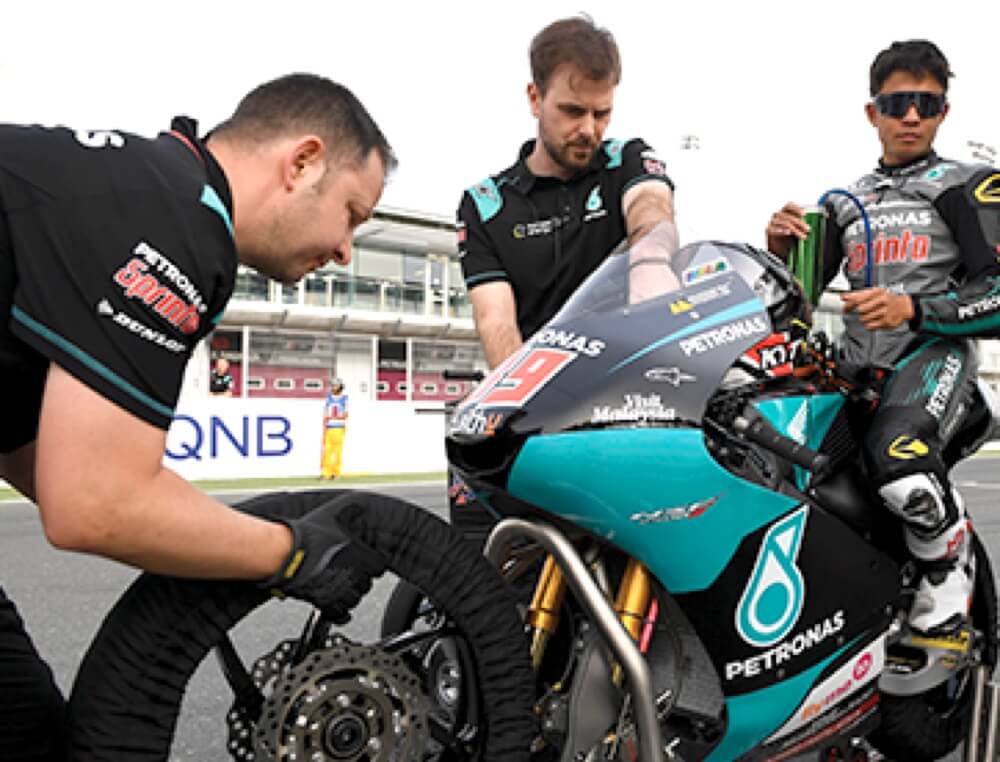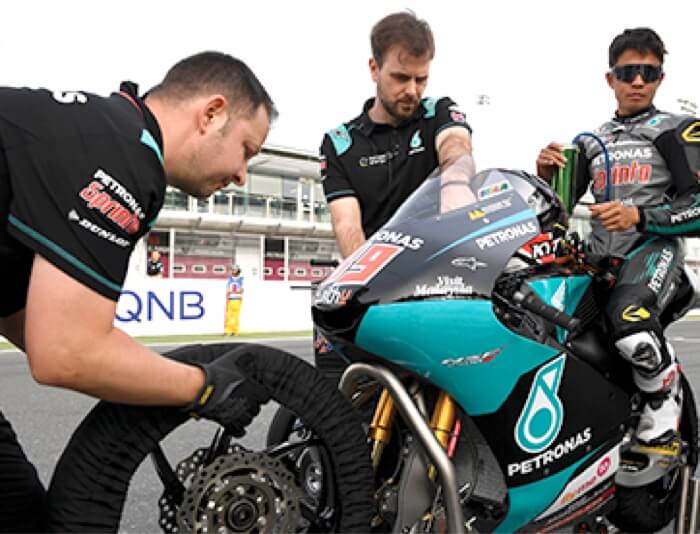It is no small feat to win the Formula OneTM World Championship double title. Many teams have done so since the first race more than half a century ago. But none were able to achieve the historic feat that Mercedes-AMG PETRONAS Formula OneTM Team pulled off, clinching both the driver's and constructor's titles six consecutive times from 2014 to 2019.
10/06/2020 • 8 mins read
Behind the Winning Chemistry
PETRONAS Fluid Technology SolutionsTM.
Brigitte Rozario

Naturally, the team's success boils down to its impressive infrastructure in Brackley and Brixworth where the chassis and power unit are respectively developed and its no-blame culture, a philosophy that runs deep within Mercedes' talented 1,300-strong workforce, be it trackside or at base.
However, what is less visible or known is how PETRONAS has been instrumental towards the Silver Arrows' success in the modern Formula OneTM era through its Fluid Technology SolutionsTM.
It has been quite a journey getting to the point where the engine manufacturers have accepted PETRONAS as a technical partner and not just a sponsor. Today, the partnership is built upon a foundation of trust and communication. While separated by continents, Mercedes-AMG and PETRONAS hold a teleconference every month and a two-day face-to-face meeting every quarter, on top of an on-site team of expert researchers based in Turin, Italy. Through all these channels, Mercedes and PETRONAS report on developments and updates, putting everyone on the same page and ensuring that the fluid involvement is from the get-go.
The season, while pushing for that seventh double championship, the team will be testing and using PETRONAS molecules in the fluids, something that the PETRONAS Yamaha Sepang Racing Team (PYSRT) started doing last year.


Fadhli Wong Hasan Wong
Head of PETRONAS Fluid Technology SolutionsTM and Mercedes Technical LiaisonFadhli Wong Hasan Wong, Head of PETRONAS Fluid Technology SolutionsTM and Mercedes Technical Liaison, explains that it took a while to win Mercedes's trust. The relationship started out a bit more distant, with PETRONAS developing the fuels and lubricants independently and then handling it over to the team for testing.
"After a few years, we realised that the dynamics of our relationship needed to change before we could make progress. We could not continue working with such levels of secrecy."
"When Toto Wolff stepped in as the new Chief Executive Officer of the Mercedes-AMG PETRONAS F1 Team, he embarked on an integration exercise on the power unit and fluid development, among others, to increase efficiency and delivery results"
"That was when the engineers from Mercedes and the chemists from PETRONAS sat down together, enabling a greater level of cohesion between us. Mercedes began to understand our fluids, and we began to understand the technical aspects of the Mercedes engine. We started building a better relationship with more trust. The results were immediate, that was the point when the team started winning races," explains Fadhli.
Two years ago, PETRONAS launched its research and development (R&D) programme. This is when FTS was set up and the search for new chemistries began.


The Push for Patented Components
In the last quarter of 2018, FTS began intensive work with Yamaha Motor Co Ltd (Yamaha). A team from FTS went to Japan and started the testing and validation of fluids in the Yamaha YZR-M1 engine as PETRONAS expanded its presence in MotoGPTM through the PYSRT in 2019.
While the work was stressful and intense, the fruits they sowed made it worth it. The work led to the first usage of ETRO+ base oil in a motorsports fluids formulation, something that has never been done before, displacing the previous Group IV Poly-alpha-olefin (PAO) base oil. This is a significant achievement as the Group III ETRO+ base oil produced in PETRONAS' Group III plant in Melaka has proven to be superior compared with PAO. ETRO+ is currently used in PETRONAS' commercial lubricants such as Syntium and Sprinta for MotoGPTM.


"Formulation is a science and it is as important as the ingredients. Based on our experience in motorsport, I can now say we must formulate using PETRONAS propretary chemistry."
DR ANDREA DOLFI
Head of R&D Fluid Technology SolutionsTM


By June last year, PETRONAS introduced Sprinta to the PYSRT, formulated to provide performance and reliability. Prior to that, Tutela was introduced to the team, designed to provide reliability and protect the gearbox.
Both fluids were delivered ahead of the initial two-year timeline provided by Yamaha, an impressive achievement by the FTS team. Results were also immediate as Fabio Quartararo picked up seven podiums and six pole positions to win the Rookie of the Year Award, and while teammate, Franco Morbidelli consistently finished in the top 10. Ultimately, this led PYSRT to win the 2019 MotoGPTM Best Independent Team Award.
“It was the first time that we were using major components produced and engineered by PETRONAS. Motorsport fluids are very tough in terms of performance requirements. Because they serve a very high-demanding application, you need a special chemistry,” explains Dr Andrea Dolfi, Head of Research and Development at FTS.
He added that he wanted to use one of the major components produced by the PETRONAS refinery in Melaka. It was a lot of work but the FTS team succeeded in delivering a fluid based on PETRONAS chemistry.
“Formulation science is not a trivial thing. It's like when you go grocery shopping where you buy a set of ingredients. The way you put them together matters a lot. With the same ingredients, you can produce a very mediocre dish or you can have a Michelin star meal.”
“Formulation is a science and it is as important as the ingredients. Based on our experience in motorsport, I can now say we must formulate using PETRONAS proprietary chemistry. That's how we ended up having ETRO+ in the MotoGPTM engine oil,” he says via videoconference from the PETRONAS Global Research & Technology (GR&T) centre in Turin, Italy.
Search for Winning Chemistry
While ETRO+ has been used in MotoGPTM, it has yet to be applied in Formula One. Dr Dolfi has challenged his colleagues to address this gap and the result was a new formulation that increases performance gains.
“This is racing. All that matters is winning. To win, there are two important elements. First, you have to be quicker than your rivals. Second, you have to finish. If you break something or suffer engine failure, you lose points. Hence, it is of paramount importance that we deliver performance without compromising reliability – that is the challenge we are faced with. Particularly in Formula OneTM, the sweet spot is not in the base oil but in the other chemistry. That is why we did this work with this new component,” says Dr Dolfi.


The new formulation was tested on the Mercedes power unit in the first quarter of last year and will be deployed in the first race this year. What you have today on the track is work from the previous year.


Thrill of the Chase
While not all PETRONAS chemists involved in delivering fluids for Formula OneTM are motorsport fans, the women and men in white coats were thrilled to come up with new formulations for fuel and lubricants for the fastest car in the world. Dr Dolfi says that remaining glued to the TV to watch speeding cars is a job he has left to the motorsport fan in his family – his wife.
“I like it but what thrills me is the technical challenge. Let's be better than our competitors. Before 2014, we had four years with Mercedes where we weren't winning anything but we did a good job. We integrated with the team.”
“The R&D team feels extremely proud of the six consecutive double wins. I've been doing this since 2013. In terms of experience, I don't know what it means not to win,” he says proudly in recognition of his team’s hard work.
Formula OneTM is a fast-paced environment and work on the fluids goes on throughout the year. There can be up to three engine upgrades in a single season. This is something FTS has and must continue to keep up with. Hence the fuel and engine lubricant need to be improved following each engine upgrade. Throughout a season there could be three different engine oil and fuel formulations.
According to Fadhli, every year, when PETRONAS presents its fluids to Mercedes-AMG, there are incremental improvements in speed.
“Over the last 10 years, we delivered around 1,000 milliseconds to Mercedes. It's a big deal. Every time we deliver a fluid, we gain 10 to 30 milliseconds.
What do 10 to 30 milliseconds mean in motorsports? It can determine if you are the winner or if you are last. Even 10 milliseconds means a lot.”
FADHLI WONG HASAN WONG Head of Fluid Technology SolutionsTM“To create biofuel you need to keep growing crops and relying on agriculture. If things progressed further, you could find yourself competing with the food industry. Even with biomass, there is a limit to how much you can do. So, instead of biomass energy and biofuel, we think that the focus should be on sustainable energy and sustainable fuel.
That means we capture and use waste gases, industrial emissions or carbon dioxide to produce petrochemicals. That makes it a more sustainable fuel," he explains. This is one of FTS' current R&D projects.
The Call to Go Greener
Motorsport and, in particular, Formula OneTM, gives PETRONAS the chance to stay on top of the mobility industry because it's the pinnacle of motorsport. The fanciest, most unthinkable, most complicated and trickiest technologies are tried here as long as they do not infringe regulations. Whatever comes into world application today was tried and tested in Formula OneTM about 10 years ago. Being involved in motorsport pushes PETRONAS to go further and achieve more in terms of performance.
There is a never-ending need to obtain more performance from the power unit and the fuel, and how the fluids react. As such, FTS is constantly looking for new ingredients and trying to create new chemistries that will boost the fluids that go into the fastest cars on the planet.
The demands, however, are not just in terms of performance; there is also the green thrust.
Formula OneTM and the Fédération Internationale de l'Automobile (FIA) aim for the sport to be net-zero carbon by 2030. As a first step, Formula OneTM also announced that carbon-reduction projects were to begin immediately with rules demanding that the petrol used in Formula OneTM must have a biofuel content of at least 10 per cent by 2021.
To ramp up the percentage from approximately 5 per cent at the current juncture to 10 per cent in a sustainable and cost effective manner within just three years seems like a steep uphill battle.
Fadhli believes the push should also be for sustainable fuel rather than biofuel. While biofuel sounds good, it means the fuel is derived from biosources such as sugarcane, corn, oil palm, agricultural wastes and derivatives. Thus, it will be hard to sustain, not to mention costly.
“To create biofuel you need to keep growing crops and relying on agriculture. If things progressed further, you could find yourself competing with the food industry. Even with biomass, there is a limit to how much you can do. So, instead of biomass energy and biofuel, we think that the focus should be on sustainable energy and sustainable fuel. That means we capture and use waste gases, industrial emissions or carbon dioxide to produce petrochemicals. That makes it a more sustainable fuel,” he explains. This is one of FTS' current R&D projects.
According to him, biofuels and sustainable fuels are coming in big and fast. There is a huge demand especially in big cities where travel involves short distances. In such cases, greener fuels should be the way to go. “It's all about emissions and how we can have better sustainability in future mobility,” says Fadhli.
The Fluid Technology SolutionsTM Track Record
R&D Projects
-
Battery Thermal Management FluidsLooking into ways to help electric vehicles reach maximum performance when operating at various conditions, and to prolong battery life.
-
BiofuelResearching conversion of algae and other second and third generation bio-based feedstock into fuel. Exploring the possibility of turning natural rubber into fuel bio component.
-
Sustainable FuelLooking into capturing factory waste gases and plant emissions, and feeding them to microbes to produce ethanol.
-
Hydrogen FuelExploring ways to turn carbon dioxide into hydrogen for hydrogen fuel.
-
Alternative FeedstockTrying out alternative feedstock like plastic wax or condensates to produce base oil which is used in lubricants.
Right Solution at the Right Price
Everything that PETRONAS learns from delivering performance and reliability for motorsport is applied in the delivery of mass-market products. Though the process is not as simple as taking the fluids from the racing machines and putting it into everyday motor vehicles.
Fadhli explains that if you use Formula OneTM fuel on the road, the car may not even start. If it does start, it may overheat and damage the engine because Formula OneTM fuel is developed for high performance and combustion.
Instead, the learnings from motorsport are optimised for commercial products. Through its involvement in Formula OneTM and MotoGPTM, PETRONAS learns how to deliver the best performance for passenger and commercial cars and motorcycles.
“The beauty of working with motorsport and new chemistry is that if it works for them, it must work for everything else. The performance demand is so high that if it's good enough for Formula OneTM, it must be pretty good for anything else in terms of chemistry. Then, of course, you have to redeploy accordingly into different applications. That's where we go back to formulation science. You have to have the right solution for the right customer at the right price.”
“When we say Formula OneTM is tough, it is because the sport is the pinnacle of technology. We are trying things that nobody has ever dared try because we want to go faster. We want to go faster because we want to win. It's as easy as that.”
“So, we are looking at a lot of medium- and long-term projects, and PETRONAS should and must benefit from this work because what is now niche and being researched, could be commercialised in 10 to 15 years,” says Dr Dolfi.
A Path Fraught with Challenges
Working in R&D is not as enviable and easy a job as one would think. Among the challenges Dr Dolfi faces is nurturing talents and the transfer of knowledge so that there is continuity in the culture and mindset which he believes are pivotal to the success they have been enjoying.
“We want to establish a culture of high-performance research that will serve PETRONAS well.”
“We want to establish a culture of high- performance research that will serve PETRONAS well. As a senior technical leader, my key task is to transfer the way we work, think and challenge ourselves so that this culture is not lost. We want to establish something that will last for years to come so that we can sustain this level of success. We also need to nurture talents so that they are fit to take over when the time comes,” he adds.
While the FTS R&D team is only about 20-people strong, Dr Dolfi believes with the right coordination, mindset, tools and managerial support, FTS can do wonders.
“Research by definition is agile. We sometimes compete concurrently with others on the same technologies. Everybody is competing so research is also a race. It needs a dynamic and agile environment to operate as fast as possible. In addition, nobody likes to fail but research has a high degree of failure. You try things that are new and you don't know if it will succeed. It is in the nature of research to involve failure, but a good manager knows when to take a calculated risk of failure. You try something, it doesn't work, and you try something else. The more things you try, the better chance of achieving success in the years to come.”
“Formula OneTM, and racing in general, is a lot about pushing the boundaries. I invite everybody to challenge and try new things and dare to go beyond, but with calculated risks and putting safety first. Dare but with a scientific mindset. Every company including PETRONAS needs this attitude to move forward in a very competitive world,” sums up Dr Dolfi.







